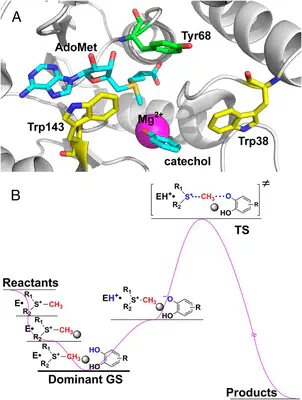
Abstract
Enzymatic methyl transfer, catalyzed by catechol-O-methyltransferase (COMT), is investigated using binding isotope effects (BIEs), time-resolved fluorescence lifetimes, Stokes shifts, and extended graphics processing unit (GPU)-based quantum mechanics/molecular mechanics (QM/MM) approaches. The WT enzyme is compared with mutants at Tyr68, a conserved residue that is located behind the reactive sulfur of cofactor. Small (>1) BIEs are observed for an S-adenosylmethionine (AdoMet)-binary and abortive ternary complex containing 8-hydroxyquinoline, and contrast with previously reported inverse (<1) kinetic isotope effects (KIEs). Extended GPU-based computational studies of a ternary complex containing catecholate show a clear trend in ground state structures, from noncanonical bond lengths for WT toward solution values with mutants. Structural and dynamical differences that are sensitive to Tyr68 have also been detected using time-resolved Stokes shift measurements and molecular dynamics. These experimental and computational results are discussed in the context of active site compaction that requires an ionization of substrate within the enzyme ternary complex.